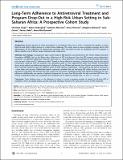| dc.contributor.author | Unge, Christian | |
| dc.contributor.author | So¨derga˚rd, Bjo¨ rn | |
| dc.contributor.author | Marrone, Gaetano | |
| dc.contributor.author | Thorson, Anna | |
| dc.contributor.author | Lukhwaro, Abigael | |
| dc.contributor.author | Carter, Jane | |
| dc.contributor.author | Ilako, Festus | |
| dc.contributor.author | Ekstro¨ m, Anna Mia | |
| dc.date.accessioned | 2021-09-01T21:23:55Z | |
| dc.date.available | 2021-09-01T21:23:55Z | |
| dc.date.issued | 10/25/2010 | |
| dc.identifier.citation | n: Unge C, So¨derga˚rd B, Marrone G, Thorson A, Lukhwaro A, et al. (2010) Long-Term Adherence to Antiretroviral Treatment and Program Drop-Out in a High-Risk Urban Setting in Sub-Saharan Africa: A Prospective Cohort Study. PLoS ONE 5(10): e13613. doi:10.1371/journal.pone.0013613 | en_US |
| dc.identifier.other | DOI:10.1371/journal.pmed.0040298 | |
| dc.identifier.uri | http://repository.amref.org/handle/123456789/215 | |
| dc.description | : 2010 Unge et al. This is an open-access article distributed under the terms of the Creative Commons Attribution License, which permits
unrestricted use, distribution, and reproduction in any medium, provided the original author and source are credited | en_US |
| dc.description.abstract | Background: Seventy percent of urban populations in sub-Saharan Africa live in slums. Sustaining HIV patients in these
high-risk and highly mobile settings is a major future challenge. This study seeks to assess program retention and to find
determinants for low adherence to antiretroviral treatment (ART) and drop-out from an established HIV/ART program in
Kibera, Nairobi, one of Africa’s largest informal urban settlements.
Methods and Findings: A prospective open cohort study of 800 patients was performed at the African Medical Research
Foundation (AMREF) clinic in the Kibera slum. Adherence to ART and drop-out from the ART program were independent
outcomes. Two different adherence measures were used: (1) ‘‘dose adherence’’ (the proportion of a prescribed dose taken
over the past 4 days) and (2) ‘‘adherence index’’ (based on three adherence questions covering dosing, timing and special
instructions). Drop-out from the program was calculated based on clinic appointment dates and number of prescribed
doses, and a patient was defined as being lost to follow-up if over 90 days had expired since the last prescribed dose. More
than one third of patients were non-adherent when all three aspects of adherence – dosing, timing and special instructions
– were taken into account. Multivariate logistic regression revealed that not disclosing HIV status, having a low level of
education, living below the poverty limit (US$ 2/day) and not having a treatment buddy were significant predictors for nonadherence. Additionally, one quarter of patients dropped out for more than 90 days after the last prescribed ART dose. Not
having a treatment buddy was associated with increased risk for drop-out (hazard ratio 1.4, 95% CI = 1.0–1.9).
Conclusion: These findings point to the dilemma of trying to sustain a growing number of people on life-long ART in
conditions where prevailing stigma, poverty and food shortages threatens the long-term success of HIV treatment. | en_US |
| dc.language.iso | en | en_US |
| dc.publisher | PLoS ONE | en_US |
| dc.title | Long-Term Adherence to Antiretroviral Treatment and Program Drop-out in a High-Risk Urban Setting in Sub-Saharan Africa: A Prospective Cohort Study | en_US |
| dc.type | Article, Journal | en_US |

